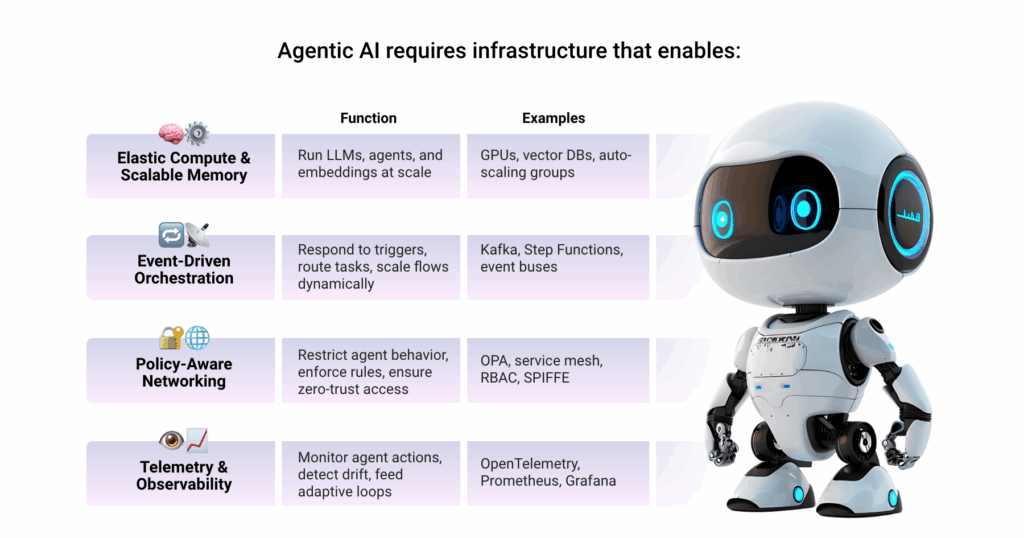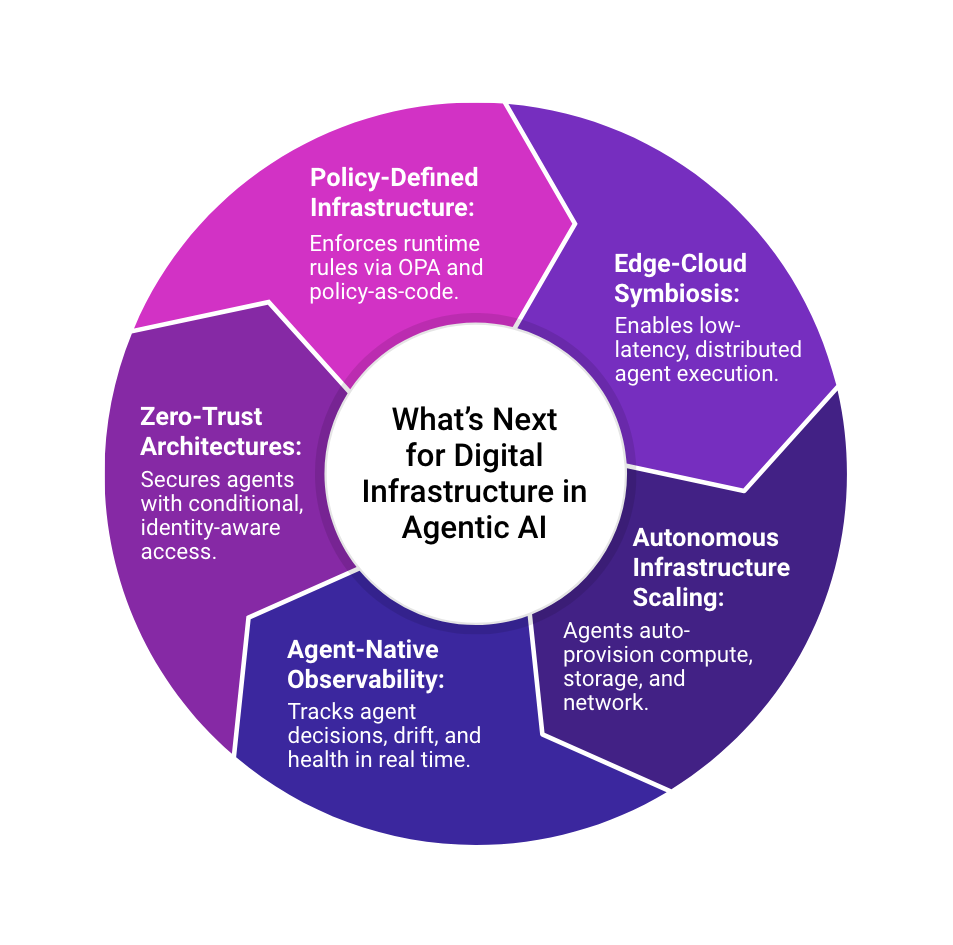Digital infrastructure powers agentic AI with scalable compute, storage, networks, APIs, and orchestration layers.
Brief Definition
Digital infrastructure refers to the scalable, secure, and interconnected technology foundation that supports modern AI systems and enterprise operations, including compute, storage, networks, APIs, and orchestration layers.
Detailed Definition & Explanation
Digital infrastructure is the technological backbone that enables modern businesses to operate, scale, and evolve. It includes cloud environments, networking stacks, data storage, API layers, compute resources, and increasingly, intelligent orchestration and observability frameworks.
Digital infrastructure typically spans four major categories:
- Core Infrastructure: Foundational layers like compute, storage, and networking (e.g., data centers, cloud providers).
- Application Infrastructure: Platforms and tools that support application deployment, such as container orchestration, serverless frameworks, and service meshes.
- Integration Infrastructure: APIs, messaging buses, and event-driven architectures that connect systems and allow agent-to-agent communication.
- Governance Infrastructure: Includes security, compliance, observability, and policy enforcement mechanisms like identity management, logging, and policy-as-code tools (e.g., OPA).
In Agentic AI ecosystems, these infrastructure layers are tightly integrated to support autonomous execution, continuous adaptation, and secure coordination between agents at scale.
Agentic AI requires infrastructure that enables:
- Elastic compute and scalable memory for real-time inference and vector database access
- Event-driven orchestration for distributed workflows across departments or domains
- Policy-aware networking that governs access based on identity, trust, or task context
- Telemetry and observability for tracking agent behavior, drift, and compliance

Without a robust digital infrastructure, autonomous agents cannot operate at scale, collaborate across silos, or maintain the responsiveness required in high-stakes business environments.
Why It Matters
Powers Autonomous Agent Execution
Digital infrastructure provisions and deploys agents using containerized environments, service mesh configurations (e.g., Istio), and infrastructure-as-code frameworks (e.g., Terraform). Agents register with orchestration hubs, enabling real-time coordination, retry logic, and failover between services via gRPC or message queues.
Supports Dynamic Workflows
Low-latency APIs and event-driven backplanes (e.g., Kafka, NATS) allow agents to subscribe to signals, trigger stateful workflows, and sequence tasks across domains. Infrastructure enables agents to invoke REST/GraphQL endpoints, adapt to changing process logic, and route outcomes based on dynamic inputs.
Enables Secure, Governed Operations
Digital infrastructure integrates with OPA (Open Policy Agent) and identity layers (e.g., OAuth2, SPIFFE) to enforce policy-as-code at runtime. Agents inherit role-based access controls (RBAC), enabling them to act only within scoped privileges, while logging every action for compliance via observability stacks (e.g., OpenTelemetry).
Scales with Enterprise Complexity
Elastic scaling is handled via Kubernetes-based orchestration (e.g., KEDA, HPA), auto-scaling groups, and resource-aware schedulers. Agents can be replicated across multi-zone clusters, with intelligent load balancers routing based on latency, cost, or agent specialization.Forms the Foundation for Continuous Intelligence
Digital infrastructure connects agents to analytics engines, vector databases (e.g., Pinecone, Weaviate), and real-time stream processors. Agents query telemetry, update semantic memory, and adapt behavior mid-execution based on inference or environmental feedback.
Real-World Examples
Microsoft Azure Arc + Azure Kubernetes Service (AKS)
Microsoft Azure Arc with AKS offers a robust digital infrastructure for Agentic AI by enabling consistent deployment and management of Kubernetes clusters across cloud, edge, and on-prem environments. It supports hybrid operations, integrates with Azure’s policy and identity layers, and automates workload scaling, all essential for autonomous agents operating in distributed settings.
AWS Nitro + Lambda + Bedrock
AWS Nitro, Lambda, and Bedrock form a scalable and secure digital infrastructure ideal for Agentic AI. Nitro enhances workload isolation and trust, while Lambda provides serverless compute for real-time, event-driven agent actions. Bedrock enables seamless integration with foundation models, allowing agents to generate responses, analyze data, or trigger next steps autonomously. Together, they create an architecture that supports autonomous, low-latency decision-making without manual provisioning or infrastructure overhead
FD Ryze
FD Ryze is built on a policy-aware digital infrastructure that allows agents to self-deploy across hybrid environments, leveraging containerized microservices, secure APIs, and real-time orchestration. Its infrastructure stack ensures autonomous agents can scale and collaborate with minimal latency. Telemetry, compliance hooks, and role-based controls are integrated to maintain visibility, trust, and control as agents act across enterprise workflows.
What Lies Ahead

1. Policy-Defined Infrastructure
Digital infrastructure will evolve to support real-time, context-sensitive governance using OPA and policy-as-code standards. This means infrastructure must be programmable, rule-enforced at runtime, and tightly integrated with identity, data, and task-level controls.
2. Edge-Cloud Symbiosis
Infrastructure will blend cloud and edge resources dynamically, allowing agents to operate closer to the data and users. This will require unified orchestration, latency-aware routing, and workload portability across distributed environments.
3. Autonomous Infrastructure Scaling
Agents will increasingly provision and scale their own environments using infrastructure APIs and telemetry. Digital infrastructure will need to expose intelligent provisioning hooks and self-optimization capabilities for compute, storage, and network layers.
4. Agent-Native Observability
Monitoring tools will provide agent-level insights, not just for uptime but for decision traceability, drift, and collaboration health. This demands telemetry infrastructure that’s granular, context-aware, and tied to agent actions rather than just services or nodes.
5. Zero-Trust Architectures for Agentic AI
Security models will treat agents as first-class identities, enforcing conditional access and continuous verification at every layer. Digital infrastructure must integrate with identity-aware proxies, policy engines, and behavioral analytics to validate every agent action in real time.
Related Terms
- Cloud and Infrastructure
- Agentic AI
- Policy-as-Code
- Container Orchestration
- Microservices Architecture
- API Management
